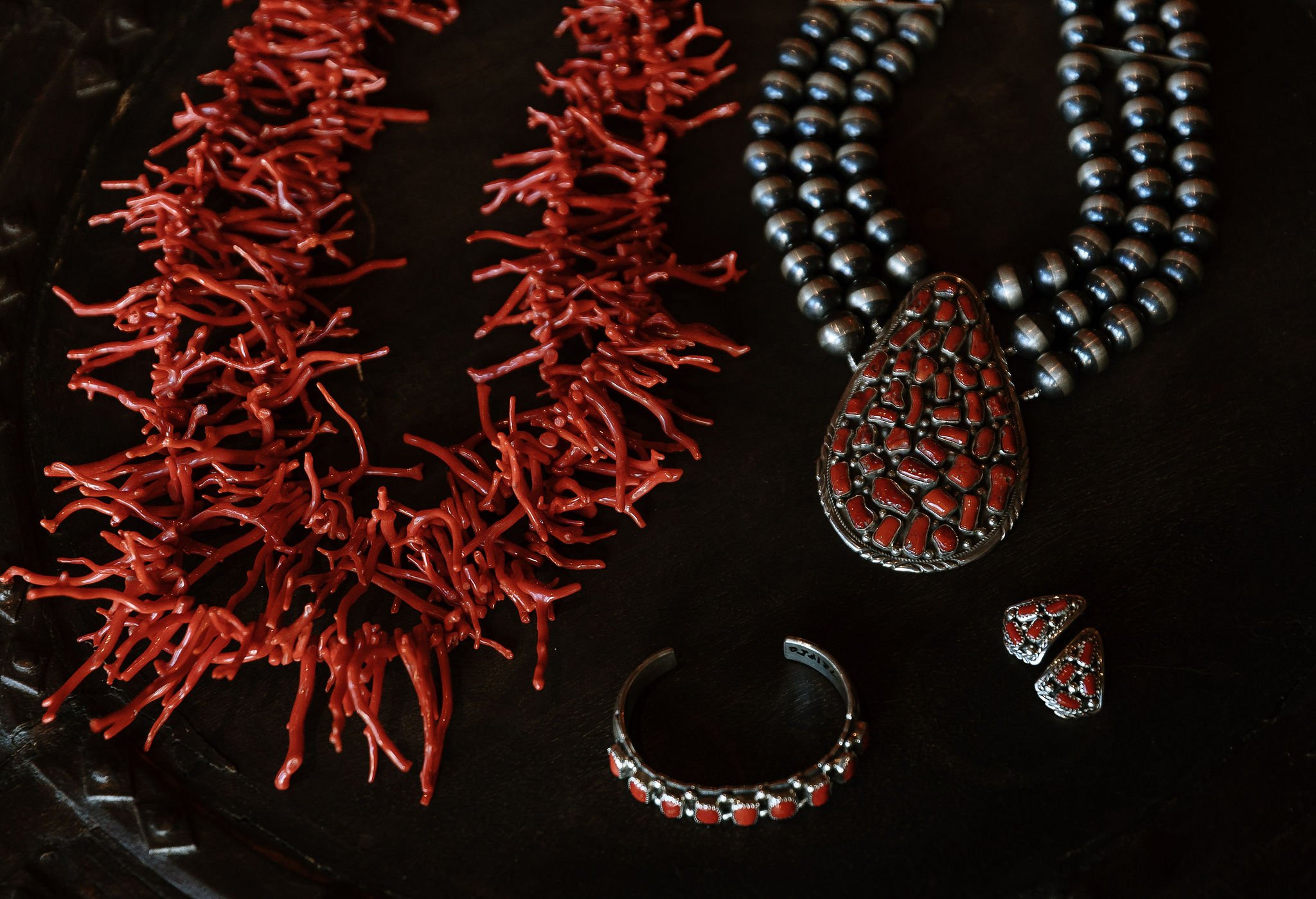
Introduction to collecting Native American jewelry
The first time you are stopped on the street wearing your gorgeous turquoise squash blossom with red stones on it and asked what the crescent pendant on the bottom is called will you know how to respond? Reading the following will give you a crash course in all you need to know.
Ceremonial: Ceremonial is a vital part of Native American culture. There are many different types of ceremonies centering around spirituality, ceremonies are used primarily for healing or the restoration of hózhǫ́ (harmony and balance). At these ceremonies you will find traditional Native American jewelry worn in hour of the spiritual event. In New Mexico tourist visit from all over the world yearly to witness the inter-tribal ceremonial in Gallup. Today, you will find the crowning of Ceremonial queen and a week-long celebration to follow.
Coral: Coral has been used by tribal artisans for over 600 years. There are many types of coral used. You may come across coral that looks like a tree; what a treat if you do. This is known as Mediterranean Branch coral and is typically sourced from European seas displaying an intense red color. Branch coral is rare and very delicate. You will find coral mixed with sterling silver and turquoise in many forms of Native American jewelry.
Fetish: Fetishes are small carvings, usually animals, made of different indigenous materials to that region such as clay, stone, bone or shell with the most common being serpentine, a soft stone. Zuni people have long used fetish carvings for religious and ceremonial purposes. Fetishes are traced back to a legend about when all animals were turned to stone by certain deities. All hunting fetishes are representations of these original animals. It’s rare to find authentic vintage fetish necklaces which are highly sought after. Vintage fetishes vs today’s fetish’s are very different in size and stone.
Heishi: (pronounced "hee shee") literal translation to shell, are small disc or tube-shaped beads made of seashells or ground and polished stones, like turquoise. They come from the Santo Domingo Pueblo of New Mexico. You will find heishi beads on various forms of jewelry in different shapes and sizes.
Inlay: Inlay is a form of jewelry where a stone is cut and polished to a unique shape and glued. There are no prongs or padded settings on inlay pieces. Once the stone is set it is typically the same level as the surrounding metal forming a smooth surface.
Jacla: A loop beaded feature traditionally used as earrings later added to the bottom of a heishi necklace as an accessory. Usually, strung on string or twisted yarn. You will find this style used frequently for ceremonially purposes within the tribes.
Naja: Naja’s literally translation is crescent. Which resembles its half-moon shape. It is representative of the womb; where you will see a single nugget of turquoise suspended from a pendant symbolizes a child growing within. You typically see najas on squash blossom necklaces.
Navajo Pearl: A Navajo Pearl is rounded shape bead made from sterling silver by Navajo (Diné) silversmiths. They are similar in shape to a traditional oyster pearl, hence the name. Beads are either handmade or machined. Handmade beads are extremely difficult to construct. The art of bead making has been passed down in families for many generations. You will find Navajo Pearls on a strand alone, placed on squash blossom necklaces, bracelets, or earrings. They can be worn on a single strand necklace or layered with a pendant.
Needle Point: Is a style of jewelry introduced in the early 1900’s by the Zuni tribe. Stones, often turquoise, are cut into very small pieces shaped like a needle then grouped together to form a very delicate design.
Old pawn: Is a term used for Native American jewelry, made and worn by Native Americans, typically not available for sale to the public. Traditionally, old pawn pieces were taken to a Trading Post, where the items were pawned for a certain amount of money and then redeemed when the sum was paid back to the trading post. The jewelry that is considered "Old Pawn" is extremely rare and valuable to collectors, as a truly authentic piece of jewelry, made for Native American use. When the pieces were not paid for after some amount of time, they become what is known as “dead pawn” and are available for sale.
Patina: Is a film that develops on the surface of metal over a period of time typically sterling silver in Native American jewelry. It takes decades for the patina to develop and may appear grayer in dry climates like the southwest. Humidity will add a darker, blacker patina. Often silversmiths will put an instant patina on jewelry to give an antique finish. Patina isn't buffed off in order to preserve its history and value. You will find authentic old pawn jewelry will have a greater amount of patina indicating age. Please do not ever remove the patina will chemicals. If you have to clean or polish jewelry, we recommend using a silver cloth or old denim and wipe with medium pressure.
Silversmith: A silversmith is an artist that works in the form of silver typically by hand with stones like turquoise, coral and shell. Silversmithing has been passed down for many generations within Native American families. It is important to support this art as traditional handmade methods are hard to come by.
Spiny Oyster: Spiny Oyster is a shell that is harvested in Baja California. It comes in a varity of colors from orange, deep purple, rich red and in rare cases bright yellow. The Spiny Oyster otherwise known as spondylus, is a large family of mollusks. Also known as a thorny oyster. The animal is encased in a hinged shell composed of two parts. Large quills grow from their shells.
Squash Blossom: A necklace crafted in silver and turquoise consisting of round silver beads interspersed with beads that look like they are blooming, all leading down to what looks like a horseshoe known as a Naja. Squash Blossom necklaces symbolizes one’s status, wealth and cultural belonging.
Sterling Silver: Is sterling silver real silver? The answer is yes. Fine silver is alloyed with copper to create sterling silver, which is 92.5% pure silver and 7.5% copper. This percentage of fine silver is why you will sometimes see sterling silver referred to as 925 or hallmarked with a 925 on your jewelry. Majority of the Native American jewelry you will see is made with sterling silver.
White Buffalo: Is a white and black stone only to be sourced from Dry Creek mine in Tonopah, Nevada. The stone’s name derives from the Native American belief that White Buffalo are pure and rare just like the stone. Often referred to as white turquoise, although it has a different composition then turquoise.
Turquoise: Turquoise is an opaque, blue-to-green mineral that is a hydrated phosphate of copper and aluminum. It is rare and valuable in finer grades and has been prized as a gemstone and ornamental stone for thousands of years owing to its eye-catching hue. We strive to only offer authentic, ethically sourced, turquoise mined in the United States of America. You will find fake, or lab grown turquoise being marketed as genuine. Know where you are purchasing your jewelry from and the artist who has created it.


